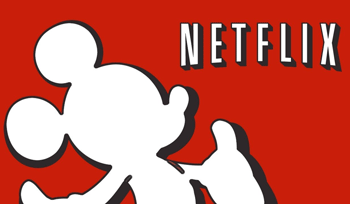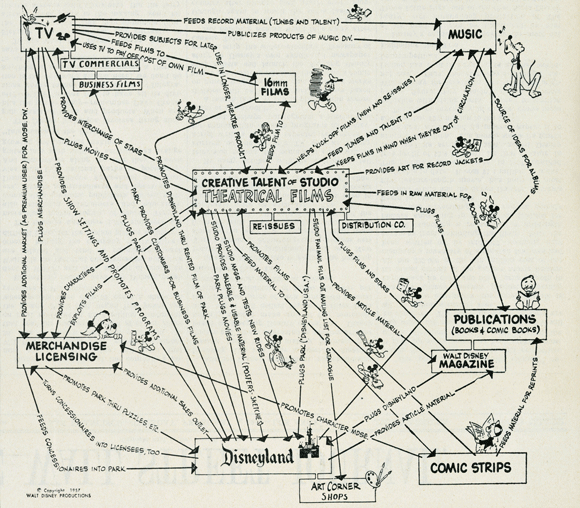Focusing on Disney’s plan to pull its movies and television shows from Netflix misses the bigger picture, which is much worse for Netflix.
By Brad Berens
According to the Center’s work, between 2003 and 2016 Americans increased their online movie viewing from two percent to 45 percent of total movie watching time. Meanwhile, offline movie watching decreased from 98 percent to 55 percent of total movie watching time during the same period.
 So it was not a surprise last week when the Walt Disney Company’s earnings report sparked intense discussion of the Mouse’s plans to launch an over-the-top (OTT) online video service like Netflix. Nor was it surprising that the company plans to pull much of its library out of Netflix in order to move it over to its new service.
So it was not a surprise last week when the Walt Disney Company’s earnings report sparked intense discussion of the Mouse’s plans to launch an over-the-top (OTT) online video service like Netflix. Nor was it surprising that the company plans to pull much of its library out of Netflix in order to move it over to its new service.
As a result, Netflix’s shares briefly dropped seven percent. (Disney also announced an OTT service for ESPN, which is a big deal, but in this column I’m focusing on the entertainment service.)
Analysts, journalists and Tweeters alike focused on how this new service would take advantage of Disney’s traditional kids-oriented content combined with Pixar, and they concluded that this would hurt or kill Netflix’s own content for kids. (Search Twitter for the word’s “Disney, Netflix, Kids” to see this discussion.) More generally, Forbes responded with the headline, “Disney Dumps Netflix, So Should Investors.”
Some contrarian writers thought this was no big deal because only parents of small children would care.
This Disney versus Netflix, head-to-head comparison simplifies a bigger set of issues; it also confuses the family-oriented Disney brand with the much larger Walt Disney Company.
Netflix is a fantastic OTT media service that is creating terrific original content and licensing other terrific content, including (at present) some from the Walt Disney Co., but it is just an OTT media service.
Netflix is doubling or tripling down on original content and expects to have negative cash flow for many years, and this means that the company can only increase its revenue by increasing the number of its subscribers and raising its prices. Paradoxically, by raising its prices Netflix will decrease its subscriber base.
In contrast, on the media side alone, in addition to kids content (including the seldom-mentioned Muppets!), the Walt Disney Co. owns Marvel, Star Wars, ABC, Hollywood Records; book publishers including Hyperion, YouTube network Maker Studios, and it has stakes in A&E, Lifetime, the History Channel, video game titles, and Vice Media. When The Walt Disney Co. removes its content from Netflix, it will have a tectonic-shift impact on the entirety of Netflix, not just the kids channel.
According to CNBC, even if Disney only charges five dollars per month for its OTT service (and generally Disney charges a premium), once it gets to 18 million subscribers the service will generate a billion dollars per year, which is three times what Disney has been making from Netflix.
Disney’s strategy is bigger than OTT
Outside of media, there are the parks and hotels, the cruises, the stores and a vast galaxy of merchandise.
Disney, in other words, has a complex strategy in which all of its many parts connect to and amplify each other to create a greater whole. This is not a new strategy: you can see the core of it in this 1957 Disney flow chart created (image taken from a 2013 Harvard Business Review article):

Although a Disney OTT service can be profitable with comparative ease, the strategic importance of that OTT service is as connective tissue among the rest of the Disney properties. Even if the service were largely ad free, Disney could promote its latest movies, television shows, and other content in pre-rolls or simply with a channel of trailers.
Likewise, as we learned in the earnings report, The Walt Disney Co. plans to launch original content on its OTT service. But unlike Netflix, Disney has multiple overlapping windows that enable it to make OTT original content profitable.
Disney did something akin to this in 2008 when it opened “High School Musical 3” as a theatrical movie, whereas the previous two installments had been ad-plus-subscription supported on the Disney Channel. “High School Musical 3” made more than $250 million dollars in worldwide box office. Next month, Disney will reverse the process by opening the first two episodes of “Inhumans” theatrically and then running the rest of the season ad-supported on ABC.
Even in the unlikely event that Disney’s OTT service was not profitable, this does not mean it would not increase profitability for the entirety of the Walt Disney Co. In other words, Disney has many more options to make its content profitable than Netflix.
Disney versus Netflix is not an apples to apples comparison: it’s apples to aircraft carriers.
An increasingly crowded ecosystem
Positioning Disney against Netflix in a head-to-head also ignores the many other players in the OTT space — most significantly Amazon, which includes its Amazon Prime Video on Demand service as a benefit of its Prime service. Amazon does this because Prime subscribers spend twice as much on Amazon as non-Prime customers. Amazon Prime Video also promotes the company’s many paid video offerings: if you don’t find the movie you want for free, then you can rent or buy it from Amazon right then and there.
When (not if) Netflix next raises its prices you can be sure that many subscribers will scrutinize its value and abandon ship, particularly if they already have a free Amazon Prime Video account that’s more than just pretty good.
_________________________________________________________________________________________________
Netflix is doubling or tripling down on original content and expects to have negative cash flow for many years, and this means that the company can only increase its revenue by increasing the number of its subscribers and raising its prices. Paradoxically, by raising its prices Netflix will decrease its subscriber base.
_________________________________________________________________________________________________
This would be true even if the only OTT services were Netflix, Amazon and Disney, but that is far from the case. The OTT video ecosystem has become as crowded as a Los Angeles freeway at rush hour.
Netflix has more competitors to worry about than Disney and Amazon.
Hulu has more new broadcast content than any other service. YouTube both sucks away attention from professional content and also has its own premium service. Apple is spending a billion dollars on original content, and Facebook just launched a new “Watch” tab with original video content.
In addition, the premium cable channels (HBO, Showtime, Starz, et cetera) are going OTT, and so are the broadcast channels. The most important broadcast channel OTT experiment is CBS All Access, which is the only place that Trekkers will be able to see the new “Star Trek: Discovery” show, the first new Star Trek television title since “Star Trek: Enterprise” left the air in 2005.
In the old days, viewers paid one cable bill. Maybe you’d shift your premium channels around, but you didn’t have to do a homework assignment budgeting your dollars against your channels.
These days, faced with so many options, viewers have to make tough choices about their entertainment. Events like a Netflix price hike will nudge viewers into reviewing those decisions: some will stick with cable and add in OTT; some will cut or shave the cable cord; some will stay loyal to Netflix, but not everybody.
Just as there will never be another Nielsen ratings giant like “Gunsmoke,” or final episode of “M*A*S*H,” or even “Night Court” (which left the air in 1992 with a 20 percent share that today would keep it around in perpetuity), there will never be another Netflix. There will never be another OTT service so dominant in the hearts, minds and wallets of viewers.
By this standard, even Netflix will never again be Netflix.
__________

Brad Berens is the Center’s Chief Strategy Officer.
See all Analysis columns.
August 24, 2017

